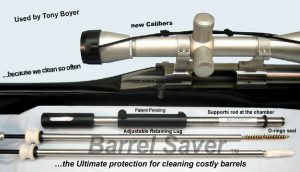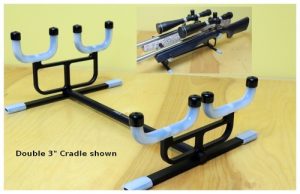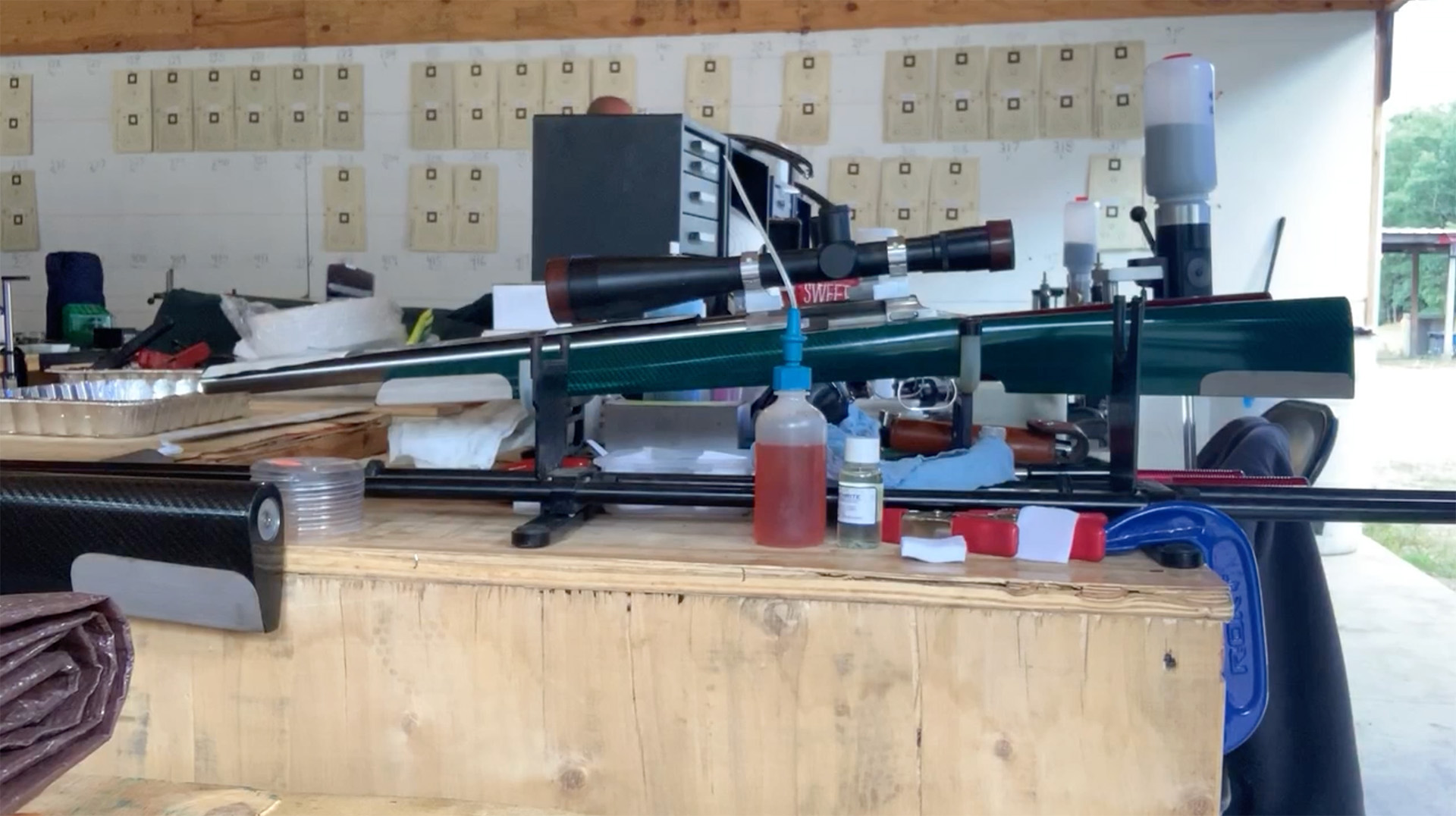Rifle barrel cleaning—learn why and how often to clean
- Because it matters for precision (and why some shooters think it doesn’t matter that much)
- This is a head game—if you don’t think that the gun’s going to shoot well, it won’t, and
- Protect your asset from fouling, pitting and corrosion.
I put together a 15-minute video showing you how I clean my precision rifle. I need to buy a lapel microphone that also dampens wind and background noise, so please bear with me in these early vlog posts.
But I wanted to get this content published to help me find out what interests you, to help me align my sights faster to give quality content to you.
To make up for the poor sound quality I’ve included a transcript with lots of additional tips and links out to other interesting blogs and sources of supplies and equipment. Enjoy!
xxxxx
Transcript—how to clean your rifle barrel
Hey everyone, it’s Vera Carter. Today I want to talk about cleaning your rifle barrel.
It’s a gorgeous spring day here. There’s almost no wind on the range, barely even a leaf moving—which is unusual for us down here.
But we might come back and do a little bit of shooting this afternoon. George has just chambered a couple of barrels and we’ll see how they work.
You’ll notice today I’m wearing my 2011 Super Shoot hat from Kelbly’s (Ohio) with my 2011 Super Shoot shirt, so we’re going to have some fun with the videos. I’ll show up with something different on just to bring back a little nostalgia from some of our shoots.
But for today let’s go over the basics of cleaning. This isn’t rocket science (it’s fairly basic), but I thought I’d give you an overview of how I clean my gun.
If you talk to five shooters and ask them how many rounds they shoot before they clean, you’ll get five different answers. The short answer is—it doesn’t really matter. It depends on your way of thinking, but we’ll go over that a little bit.
But there is some basic equipment; there are some things you really do need to pay attention to, and let’s start off with some of the equipment.
The skinny on rifle cleaning rods
I’ve got our cleaning rods here.
These are premium stainless micro-polished gun cleaning rods manufactured in America by Pro-Shot.
And you can see they’re stainless, which is important because you don’t want that cleaning rod to be too long.
My point is not the length specifically, but the strength of the rod—long flexible rods will bend. Also, the polished stainless doesn’t pick up and carry grit through the bore.
You don’t want it to be bending out the end of the barrel because then you’re going to drag that cleaning rod over the crown of your barrel, and you can damage the crown—and that’s really the secret to precision in your rifle.
Well, it’s not the only secret to precision, but protecting the barrel crown is right up there with oxygen!
Copper brush and jag
So you can see I’ve got a copper brush. Some guys will not put a copper brush through their bore, that’s fine—we find that that’s part of our equipment.
And I’ve got my jag here. These little guys will unscrew themselves over time, just by pushing them through the rifling. So I Loctite this on.
You can hear down there, is my little dog Hunter. So if you’re hearing somebody rustling around, that’s just her—making herself busy with a rock.
Bore guides
Now I’ve got the bore guides here. I use a T.K. Nollan bore guide. A little more expensive, but you can see how it’s also stainless steel, made with a lot of precision. More expensive, but it’s worth it. 
So you can see the two pieces, how they go through. You’ve got your O-rings, so that you that can keep all that solvent and crud our of your trigger. Because your trigger’s right here, and anything that comes past this is going to leak right down in and you’re going to have trigger problems. So that’s my guide.
Note: none of the links in this post are affiliate, meaning I don’t earn any commission if you visit their sites and purchase something. I just want to let you see how to get the cool stuff we have in our equipment kit.
There’s one more thing about a bore guide that’s kind of important, and that is the size. You see this guy [inner section of guide], the brush won’t go through it. That’s the right diameter that you need for a bore guide.
If it’s sloppy enough that your brush goes through it, it’s not being effective. It’s just a little too cheap—don’t bother with it.
But: a mediocre bore guide is better than no bore guide…
Rifle cleaning cradle
When I come back from the range… so… the other thing we can look at is our cleaning cradle. We have a variety of cleaning cradles. 
This one’s nice, it’s made by PMA Tool. PMA is “Precision Made in America” if that helps you remember it. It’s nice because it folds down flat for travel. And it’s sturdy—we love this. Also you can see how it grips (other than the table’s a bit rickety;).
The PMA cradle is angled so the muzzle is lower than the action—solvent will run out the muzzle end, and not back-wash into the action and trigger.
Gun cleaning solvent
But when I get back from the range then, I’ll put my bore guide in, see how that snaps in place. First thing I’ll do is put a brush through the bore—preferably when the barrel’s still hot, that helps to get the crud out of it.
We’re using Butch’s Bore Shine today. There are a variety of different solvents out there, they all work well. I will take my brush and just nudge it into the bore [guide], so there’s a hole in the top of the bore guide, and I’ll just take a squirt bottle and I’ll squirt some solvent on the brush. You want it sloppy and wet.
“Butch’s Bore Shine does not attack rifle barrels manufactured in either carbon steel or in stainless steel.”
Worried about soaking your barrel? Worried that the ammonia in Butch’s Bore Shine will corrode your bore? Check out these lab test results!
Before you push it through, put in your guide, and just a few brushes. The one thing about the brush—do you see how I’m not pushing it too far out the end, mind you this brush [rod] is not that long so I’m not going to have any problems, but just until it sticks out.
Some cleaning rods are too long, and when paired with a poor guide, can damage the crown of the barrel if they hang out too far over the muzzle.
Don’t reverse the brush in the middle of the barrel—one direction. You’ll, well, it’ll get stuck and it’ll be nasty, so you just want to push it / pull it through, and make sure you don’t try and reverse it.
This also, you see this handle, it’s nice because it rotates so that the brush is following the rifling. Out we go. So that loosens everything up with the brush.
Tip: I’m being too aggressive with the brush in the video! Slower is better. Also if you clean between each relay there’s no need to brush aggressively—patch out two wet, two dry. If you’ve only shot seven rounds it’s likely not necessary at all.
Now I’m going to take my squirt bottle, and there are a variety of different methods for this, but I just squirt something on the patch and it goes with the jag. Same thing, I just put this on the center of the patch, get it started, put in my guide, and out she comes.
Now you can see the copper fouling here. How many patches do I need? Basically until you stop seeing that blue coming out.
A good barrel should not copper foul—the copper you see on the patch is mostly from the brush. When a barrel erodes over time it will copper foul, meaning the bullet jacket is losing copper through the bore—imagine the bullet scraped across the jagged edges of cracks and pits in a worn barrel, which all diminishes precision.
One trick is when you come back from the range, if you’re going to reload and head back out again, you can leave this soak for a bit until you get your ammunition reloaded, and then patch it out and finish it off, but that’s up to you.
I don’t clean often, and there are a lot of different thoughts on that. But I can shoot a hundred rounds through a gun before cleaning it, and I don’t find that’s really a problem. Does it degrade precision—yeah, probably. I find it works all right for me.
Now just once you’ve got most of the crud out of it, push it [the patch] in and give it a little scrub back and forth.
And the other thing too, when you’re pulling this back in you don’t want that damaging the crown, I tend to be just a little bit gentle with it. And we can put a dry patch, depending on how many times you’ve shot the thing [more a reference to how many wet patches you need to remove the fouling, before you finish with dry patches.]
Another tip too with patches guys, these patches are 1½” [round], and they’re a bit too narrow, although they’re made for this barrel (or the caliber). This [square] patch is an inch and three eighths [I meant to say 1¾”], and I find that if I put this on the center, it’s going to get stuck in the bore. See, and if it gets stuck—I can already feel it, the resistance—don’t push it in too far, you’ll be in trouble. Just pull that back out again, and you can give it another try.
But I find this one’s just a bit too thick, but if I put the jag on the corner then I can—nope, it’s not going to go. So there we go [removing the guide with the stuck patch]. I don’t want to jam that in, or I’m going to have some issues with it. So—bye bye. That’s why I use 1½” round.
If you do get a patch wedged in the barrel, you can try to push it through by tapping on the handle, or you can try to pull it back out, but I’ve pulled the handle off my cleaning rod doing this. A trick is to stand your gun on the butt stock and pour cleaning solvent into the muzzle to loosen the patch, then carefully push a cleaning rod through the muzzle (don’t damage the crown!) and push the patch back into the action. DON’T DO ANYTHING ELSE UNTIL YOU REMOVE THE CLEANING ROD FROM THE MUZZLE!
But that will give you an idea of how I patch out the gun. Like they say, this isn’t genius.
I’ve found, that… I’ve put my gun away dirty (which isn’t the best idea) and ran to a shoot the next morning, and just not had enough time, just patched it out once with a dry patch and went out to the range and shot a screamer.
When we say a screamer, that’s one-tenth of an inch minute of angle. So, how much does the cleaning affect accuracy? Some guys clean after every ten rounds. For them, if that’s what they need to do, then their head tells them they need to do it.
The other thing with your cleaning, if you’re at a big shoot, if there are a lot of guys and a lot of time between matches, then cleaning the gun becomes part of the ritual. It helps keep you focused, keep you in the zone when you’re shooting. That’s important as well.
These brushes, especially if you put them away with solvent on them, they’re going to corrode, you’ll eat the brush away. They’re very much a usable commodity. So get yourself (ah, see, the wind’s picking up, there we go) you can get yourself a number of copper brushes, just discard [the used brush] at the end of the day. These I got from Plenty “O” Patches from Dan and Sue Opel out in Alberta.
The last things you need to do before you put the gun away (or before you go back out for another round), you want to mop out your chamber. That chamber you want to be nice and dry. These are great chamber tools, they’re also made by PMA Tool. So there’s your mop, so I’m going to dry out my chamber.
I want to get the lugs—these are awesome, they are a cool little idea from Pat Reagin at PMA Tool, and they come with a number of these holders, and the 2” patches (with some replacements, but you can get these in any gun store)—and they go in and will clean the lugs out. And so everything’s nice and dry there.
Don’t forget to take a paper towel and wipe off the crown.
These tuners are a patch magnet, so you want to be sure that there are no patches stuck in there. Not only will they explode cotton all over the range if you shoot them, but it’s never a good idea to obstruct your barrel, even with a patch—OK guys we’ve got to think about safety all the time.
So make sure you do that, and you should be in good shape for cleaning your rifle. And I’ll link out …
Oh yea, one more thing. When you clean your barrel, and do this every time when you come in, is wipe off the end of your bolt, and take some break clean and clean down your bolt, get the grease off the lugs so you can start fresh. And you want to get rid of any [I meant to say carbon] fouling that’s on the end of your bolt face, because you can pit it up pretty badly. I’ll put some pictures of mine on the web, I’ve done some nastiness to my bolt, which isn’t very good. It was one thing that I didn’t realize, as I was shooting, and I shoot pretty hot loads
SAFETY FIRST, ALWAYS ENSURE YOUR LOAD WILL NOT RESULT IN AN OVER-PRESSURE CONDITION FOR YOUR RIFLE!
and I was starting to get some blow-back in and around the primers
SAFETY FIRST, THIS IS NOT RECOMMENDED!
STOP SHOOTING IMMEDIATELY IF THERE ARE ANY SIGNS OF LOOSE PRIMERS!
It was putting [carbon] deposits on top of the bolt face and every time I shot it again it was burning little holes and pits in the end of the bolt.
The other thing about cleaning guys is, with us, with the stainless steel barrels for benchrest, the barrels tend to be a bit of a commodity. But if you’ve got a custom hunting rifle with a really nice custom bluing job, you don’t want to pit that up.
So although with the hunting rifles you’re not going to be shooting nearly as many rounds as we do with competition benchrest, so the cleaning is not as much about maintaining precision—you’re not looking for tenth of a minute of angle accuracy from your hunting gun obviously—but you don’t want to get it all pitted up or the bluing rusted, and you want to maintain your asset, don’t you. So before you—when you come back in from outside and you’ve got moisture on your gun, clean it up, make sure that the bore is nice and clean and you’ve got your barrels cleaned up.
Sometimes some of the benchrest rifles even, they’ll put a patch with a bit of gun oil on it, to lubricate it even for the next fouling shot. But make sure you put your gun away clean and oiled if you’ve got a lovely custom hunting barrel.
So there are lots of reasons why you clean your gun:
- Because it matters for precision, the jury’s out a little bit on that as to how many rounds you need, but
- Your head game—this is a head game guys, if you don’t think that the gun’s going to shoot well, it won’t, so keep your mental game on focus, and
- Protecting your asset, just to make sure you’re not going to pit things up—keep things nice.
So that’s it. Gun cleaning 101!
I’m really glad that you’re watching this. If you disagree with me, I’d love it if you put some comments down below.
Let me know what you think, let me know if this was valuable for you. Is it too basic? If it is, what would you like to hear about—I’d love to hear from you.
And if you’re watching this anywhere except on my blog at precisionshooting.ca, why don’t you head over there—that’s where the comments are going to go on, and I’ll be posting some additional text and some links on it. And I’d love to see you there.
Since you’re already here, please leave a comment below…
And until then, let’s stay on target!

![]()


